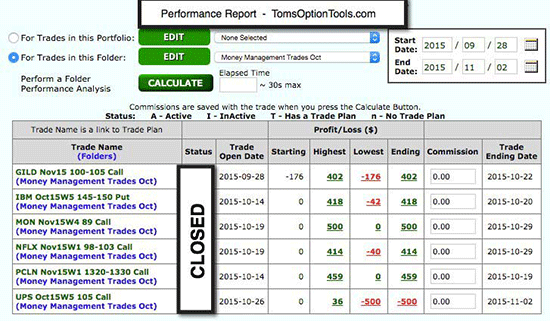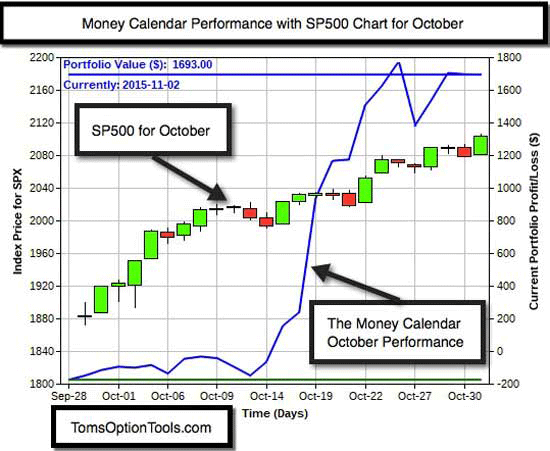One question the students in my seminars or trainings always ask each other is, "What's your winning percentage?"
But out of all the statistics to measure performance, winning percentage doesn't always tell the true measure of a trader.
I'll show you what I'm talking about...
Trader A has a winning percentage on his trades of 70%, while Trader B has a 40% winning percentage on her trades. Which trader do you think is more successful?
I'm guessing most of you picked Trader A.
But what if I told you that Trader A has a return on his money of -25% and Trader B has a positive return of 30%? Trader A wins better than 50% of the time but loses money overall, while Trader B wins less than 50% of the time, but her trades are far more profitable.
Does that change your vote? I would hope so!
You see, a trader can win a large percentage of his or her trades, but what good does that do when the small number of losses outweigh the large number of winners?
So what's the true measure of a trader's success?
Last Tuesday, I told you that two of the most important things you can do as a trader is to build a plan for every trade and to stick with that plan through the end of the trade.
But before you can build an effective options trading plan, you have to make sure you have one thing in place.
Let me show you what I'm talking about...
Three Rules for Managing Your Money
Having strict money management rules is absolutely essential to your success as a trader.
It is nice to have a good win-loss record, but if your losers are bigger than your winners, you can still lose money overall. So how do you keep that from happening?
Through proper money management.
I am not your money manager, broker, or financial planner, so I won't give you specific, personal financial advice. What I'm talking about here are some general rules for money management that have worked for me. If you like what I do and want to incorporate that into what you do, then PLEASE run these ideas by your professionals and determine what's best for you and your money.
There are three keys to managing your money as a trader...
First, know your risk!
We talk about this a lot, but it never hurts to review. From a risk perspective, if you take a fixed percentage of an account to every trade, the most damage that can be done is that fixed percentage.
For example, if a trader took 25% risk on each trade, four losses in a row could wipe the trader out.
It would take 40 losses in a row for the trader that risks just 2.5% of their account to each trade. You and you alone decide what your risk tolerance is, but its best if you think like a pro and remember that leverage is key in options, so a lot less cost and risk can be taken.
Second, spend the same amount on each trade.
[mmpazkzone name="in-story" network="9794" site="307044" id="137008" type="4"]
Whether you choose to use a percentage of your overall trading capital or you use a specific dollar amount, you should spend the same amount of money on each trade.
Sometimes the biggest concern I have is when too many positive results happen in a short amount of time. We get a string of winners and that feeds a sense of confidence that left unchecked can have one start thinking of how much MORE can be made if we just RISK more! You get on a roll and think, if only I had 10 contracts instead of three, I could have made SO much more money. So on the next trade, you go outside your management rules and you take your risk up to 50%.
Yikes!
As tempting as it is, it is wise to remain disciplined and adhere to what works.
Third, don't cherry pick your trades.
It will amaze you how the best-looking charts can fall short of expectations. So just because you think you have a sure thing doesn't mean you should put too much of your capital into a single trade.
Likewise, don't wait around for a trade that looks better than the rest - sometimes those trades that don't look like winners ahead of time can exceed expectations. If you could predict winning and losing trades ahead of time, you'd be rich.
Money Calendar's October Trades

To illustrate how these rules work in practice, I want to show you Money Calendar's six trades for the month of October. Take a look at the performance report below.
First, take a look at the six trades that were closed in the month of October. Five of the six trades were bullish, with the International Business Machines Corp. (NYSE: IBM) puts being the only bearish trade.
The next thing I want you to focus on is that based on risking no more than $500 per trade, five of the six trades had $250 per trade risk, meaning that we could have traded two contracts per position with all of them except for the Priceline Group Inc. (Nasdaq: PCLN) trade, which cost $400 per spread.
Next, in the "starting" column, you can see that only Gilead Sciences Inc. (Nasdaq: GILD) went against us on the first day. The others did not, though four of the six trades had drawdown during the trade. Only Monsanto Co. (NYSE: MON) and PCLN maintained their option value before moving higher.
Now take a look at the summary below. Basically this shows that for October, we had 83% winners and 17% losers. Our largest gain and largest loss were similar, but when you have more winners than losers, it's OK to have a 1-1 portfolio gains to losses. 
Lastly, here's how the Money Calendar compared to the S&P 500:
But this only works if you employ sound money management. Let me show you three scenarios: one for the greedy trader, one for the picky trader, and one for the calculated trader.
The greedy trader puts more of his portfolio at risk by investing way more than the same amount per trade. The greedy trader gets on a roll and puts more and more at risk with every trade. Let's say the greedy trader put 50% of his portfolio at risk on the United Parcel Service Inc. (NYSE: UPS) trade because he emotionally favors this stock. With a full loss on the UPS trade, that would cause real harm to his entire portfolio. Now this trader has to pick up the pieces and hopefully go back to that fixed-risk rule.
The picky trader may have waited and waited to see a trade that for some reason "looked better than the others," or they finally saw enough winners to finally decide to go ahead and take a trade. And guess which trade Mr. Picky takes... you guessed it... UPS. By trying to cherry pick, the picky trader got unlucky and chose the one trade of the bunch that did not work.
Then there is the calculated trader who all the while takes these trades with strict adherence to the trade and money management rule of not risking any more than the $500 per trade, and all trades are taken with close to an equal weighting in risk.
The calculated trader participated in the trades, had solid success, and yes, found out no process is 100% accurate and took a loss on the UPS trade. But the UPS loss did not wipe out a big chunk of his account, because he wasn't greedily loading up on one or two trades, and he wasn't missing out on certain trades because he was too picky.
Strive to become that calculated trader who trusts his tools and applies options trading strategies to the setups at an evenly weighted risk to the portfolio. This will give you the opportunity for greater success.
Follow us on Twitter @moneymorning.
Stick to Your Plan: There is an old adage that traders are told to live by that goes, "Plan your trade and trade your plan." It's solid advice for beginning and experienced traders alike. Changing your plan mid-trade only ever ends up reinforcing one crucial, often painful, lesson...
About the Author
Tom Gentile, options trading specialist for Money Map Press, is widely known as America's No. 1 Pattern Trader thanks to his nearly 30 years of experience spotting lucrative patterns in options trading. Tom has taught over 300,000 traders his option trading secrets in a variety of settings, including seminars and workshops. He's also a bestselling author of eight books and training courses.



